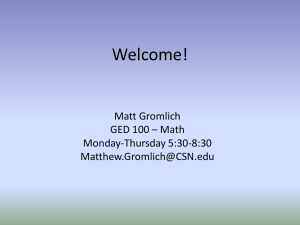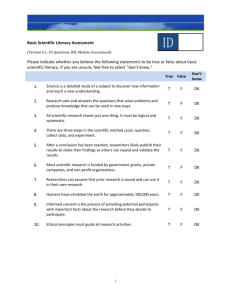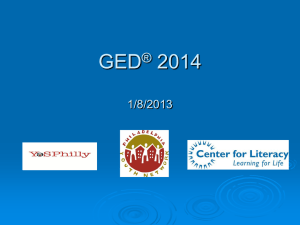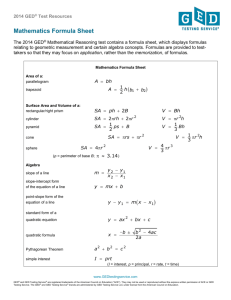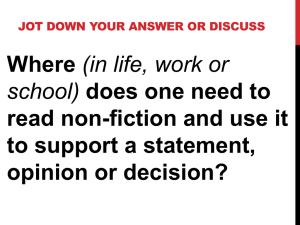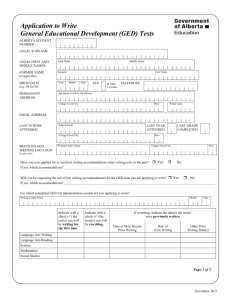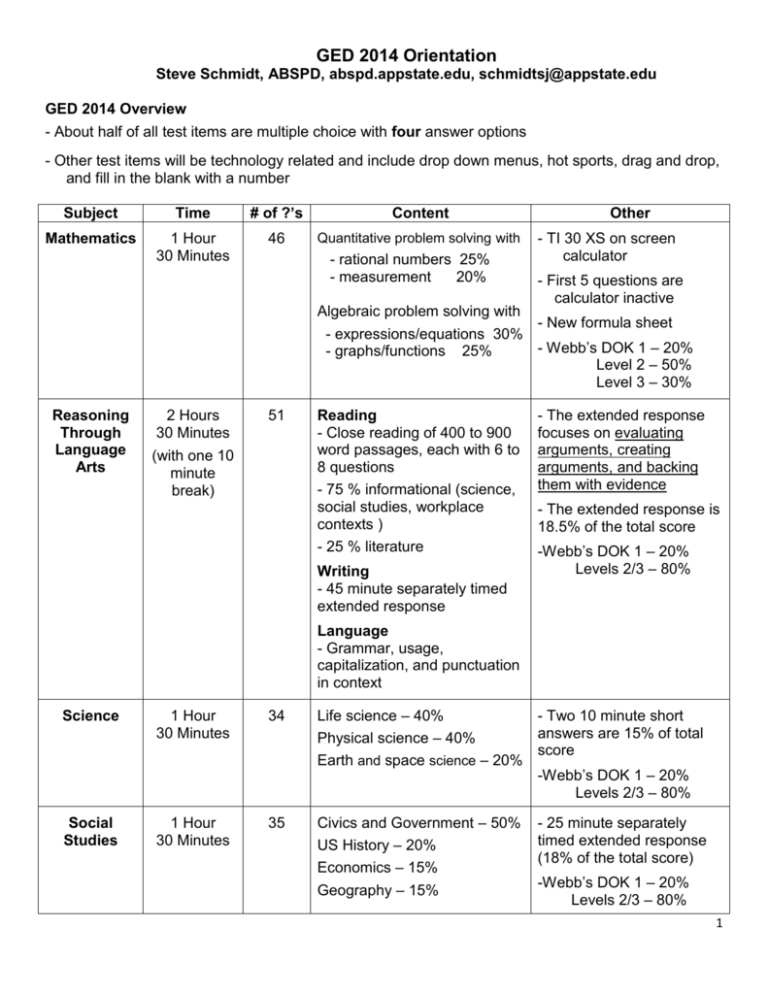
GED 2014 Orientation
Steve Schmidt, ABSPD, abspd.appstate.edu, schmidtsj@appstate.edu
GED 2014 Overview
- About half of all test items are multiple choice with four answer options
- Other test items will be technology related and include drop down menus, hot sports, drag and drop,
and fill in the blank with a number
Subject
Time
# of ?’s
Content
Mathematics
1 Hour
30 Minutes
46
Quantitative problem solving with
- rational numbers 25%
- measurement
20%
Other
- TI 30 XS on screen
calculator
- First 5 questions are
calculator inactive
Algebraic problem solving with
- New formula sheet
- expressions/equations 30%
- Webb’s DOK 1 – 20%
- graphs/functions 25%
Level 2 – 50%
Level 3 – 30%
Reasoning
Through
Language
Arts
2 Hours
30 Minutes
51
(with one 10
minute
break)
Reading
- Close reading of 400 to 900
word passages, each with 6 to
8 questions
- 75 % informational (science,
social studies, workplace
contexts )
- 25 % literature
Writing
- 45 minute separately timed
extended response
- The extended response
focuses on evaluating
arguments, creating
arguments, and backing
them with evidence
- The extended response is
18.5% of the total score
-Webb’s DOK 1 – 20%
Levels 2/3 – 80%
Language
- Grammar, usage,
capitalization, and punctuation
in context
Science
1 Hour
30 Minutes
34
- Two 10 minute short
Life science – 40%
answers are 15% of total
Physical science – 40%
score
Earth and space science – 20%
-Webb’s DOK 1 – 20%
Levels 2/3 – 80%
Social
Studies
1 Hour
30 Minutes
35
Civics and Government – 50%
US History – 20%
Economics – 15%
Geography – 15%
- 25 minute separately
timed extended response
(18% of the total score)
-Webb’s DOK 1 – 20%
Levels 2/3 – 80%
1
The Really Big Reason Not to Worry about GED 2014 is ______________________ !
“The passing standard for high school equivalency was normed on graduating high school seniors,
and the pass rate on the individual content area tests is comparable to what it was for the 2002
series.”
- Martin Kehe, VP Product Development, GED Testing Service
Name These State Capitals:
Alabama:
Florida:
Kentucky:
Nebraska:
Colorado:
Georgia:
Michigan:
Confusion:
Webb’s Depth of Knowledge Level Descriptors for Social Studies
Level 1
Level 2
Level 3
Recall of Information
Basic Reasoning
Complex Reasoning
a. Recall or recognition a. Describe causea. Explain, generalize,
of: fact, term,
effect of particular
or connect ideas,
concept, trend,
events
using supporting
generalization,
evidence from a
event, or document b. Describe or explain:
text/source
how (relationships
b. Identify or describe
or results), why,
b. Apply a concept in
features of places or
points of view,
other contexts
people
processes,
significance, or
c. Make and support
c. Identify key figures
impact
inferences about
in a particular
implied causes and
context meaning of c. Identify patterns in
effects
words
events or behavior
d. Draw conclusions or
d. Describe or explain: d. Categorize events or
form alternative
who, what, where,
figures in history
conclusions
when
into meaningful
groups
e. Analyze how
e. Identify specific
changes have
information
e. Identify and
affected people or
contained in maps,
summarize the
places
charts, tables,
major events,
graphs, or drawings
problem, solution,
f. Use concepts to
conflicts
solve problems
Webb’s Depth of Knowledge
Webb’s is about _________________ , not difficulty.
2
Comparing GED 2002 and 2014: Social Studies
GED 2002: Webb’s DOK Level _____
The question below refers to the following timeline:
100,000 Homo sapiens neanderthalensis: Neanderthal
35,000 Homo sapiens sapiens: Cro-Magnon
32,000 Flute: the first known musical instrument
29,000 Cave art
27,000 Figurines
23,000 Sewing needle
17,000 Spear-thrower
12,000 Bow and arrow
7,000 Ice Age ends: glaciers retreat
When Ice Age hunters invented the spear-thrower, they were able to hurl weapons faster and more
accurately than they could barehanded. How long ago is this innovation believed to have taken
place?
A) 7,000 years ago
B) 17,000 years ago
C) 27,000 years ago
D) 10,000 years after the development of the sewing needle
E) 10,000 years before the development of the sewing needle
GED 2014: Webb’s DOK Level _____
The excerpt below is from a 1947 speech by President Harry Truman.
I am fully aware of the broad implications involved if the United States extends assistance to Greece
and Turkey . . . One of the primary objectives of the foreign policy of the United States is the creation
of conditions in which we and other nations will be able to work out a way of life free from coercion.
This was a fundamental issue in the war with Germany and Japan. Our victory was won over
countries which sought to impose their will, and their way of life, upon other nations.
To ensure the peaceful development of nations, free from coercion, the United States has taken a
leading part in establishing the United Nations. The United Nations is designed to make possible
lasting freedom and independence for all its members. We shall not realize our objectives, however,
unless we are willing to help free peoples to maintain their free institutions and their national integrity
against aggressive movements that seek to impose upon them totalitarian regimes . . .
Based on the excerpt, why did the United States provide financial assistance to Greece and Turkey?
A) to eliminate public protests
B) to prevent government corruption
C) to uphold international agreements
D) to shape their foreign policy
3
Teaching for Increased Cognitive Rigor
4
Tier 2 Vocabulary Instruction
Teachers can begin by choosing academic (Tier 2) words that their students will encounter frequently
across a variety of content areas such as those below:
accelerate
contribute
fluctuate
notion
sequence
achieve
convert
focus
pertinent
species
arbitrary
demonstrate
ignore
phase
specify
assert
distinct
inhibit
prime
sum
compensate
distort
initial
principle
tradition
concentrate
equate
magnetic
region
transmit
concept
equivalent
perspective
sophisticated
approximate
definite
identify
external
modify
contrast
obtain
series
denote
illustrate
summary
complex
magnitude
require
dimension
individual
adjacent
create
formulate
obvious
shift
affect
criterion
phenomena
stable
assess
derive
impact
portion
statistic
element
innovation
proceed
technique
complicate
emphasize
intense
ultimate
conclude
establish
major
respective
undergo
consequent
presume
suffice
chapter
segment
verify
trace
conceive
function
occur
slightly
alternative
crucial
generate
passive
similar
analyze
data
assign
design
implicit
potential
status
assume
devise
imply
precede
structure
publish
technology
comply
empirical
interpret
pursue
tense
component
ensure
intuitive
evaluate
manipulate
restrict
usage
consist
evident
mathematics
reverse
valid
constant
environment
isolate
react
context
feasible
minimum
section
verbal
consultant
negative
guarantee
period
simultaneous
approach
define
expose
authorize
devote
indicate
precise
subsequent
random
theory
comprehend
entity
involve
expand
method
role
vary
construct
select
vertical
hypothesis
automatic
range
5
Teach Tier 2 Vocabulary Using Direct and Explicit Instruction
- Gaps in our readers’ knowledge about word meanings can make learning acquiring vocabulary from
reading inefficient and ineffective
- Research shows that teaching Tier 2 vocabulary to ABE students using dictionaries is not very
effective
- To develop vocabulary knowledge, direct and explicit instruction will usually be the best route
- Most ABE students can learn about 5 new vocabulary words per week.
Visit the ABSPD website for Tier 2 Vocabulary Lessons:
Google: abspd
Teaching Resources
ABE Reading
Vocabulary Lessons
6
Text Dependent Questions
- A recent study found that 80% of questions students were asked about texts they were reading
could be answered without looking at the text itself!
- Do the materials you use with students feature text dependent questions?
The Soccer War!
Soccer is an extremely popular sport through most of the world. However, as with anything
that people feel intensely about, emotions sometimes get out of hand. English fans have been known
for brawling in the stands. A riot in a game between Argentina and Chile in 1964 resulted in the
deaths of 309 people. But up until now at least, there has only been one out-and-out soccer war.
That war took place between El Salvador and Honduras, two Central American countries. The
year was 1969, and for many years the Salvadoran economy had been in a dire condition: too many
people with too little land and too few jobs created a situation of severe poverty. As a result, many
desperate Salvadorans had been illegally crossing into Honduras looking for work, and they harbored
a strong sense that they were mistreated there. So tensions were already very high at the beginning
of a World Cup qualifying match between the two countries.
The first game of the three-game play-off was held in Honduras, and the home team eked out
a 1 – 0 win in the last minute of play. Fighting broke out afterward in the streets, and the stadium was
set on fire. The second game was played in El Salvador, and the El Salvador team won. More rioting
and fires followed. By the time the third game was played, in Mexico City, an actual military
encounter appeared inevitable. And that is exactly what happened. Immediately after El Salvador’s
close victory, armies began skirmishing along the border of the two countries; then El Salvador
invaded Honduras and bombed its airfields. The war was over in less than a week, but ill feelings
between the two countries persisted for years afterward.
(From Six-Way Paragraphs, Middle Level, Third Edition, Pauk)
Which of these questions are text dependent?
1. Think about a time you played soccer. What emotions did you feel?
2. Why would a soccer game cause a riot?
3. Why did many Salvadorans feel resentment toward Honduras?
4. Explain how the war started between El Salvador and Honduras.
5. Could a soccer war start today? Explain why or why not.
With a partner, create a text dependent question for this passage:
7
A Close Reading Strategy
1. Introduction
Provide some context (background) for the text. The instructor reads the text aloud. The students
read the text independently.
2. Number the paragraphs
Number each paragraph in the left hand margin. This will help locate information.
3. Chunk: 1–3 / 4 / 5-6 / 7-8
Chunking breaks a large, overwhelming text into manageable sections. Look where
natural breaks are where the author shifts focus. Tell students where to group at first
(as in the example above) and then allow them to group on their own over time.
4. Circle key terms
Have students circle key words in the text. Key words could be:
Words that are repeated throughout the text - if you only circle 5 key words in a
text, you should have a good idea what the reading is about.
5. Underline the claims
Instead of asking students to underline “the important stuff,” have them underline the
author’s claims, the specific belief statements the author makes. Authors usually make several
belief statements in a paper.
6. Left Margin: Summarize
In the left margin, have students summarize each chunk (step 3) in 10 words or less.
7. Right Margin: Text Marking
In the right margin, have students do some text marking such as:
✔-
I knew this before
! – This is new to me
? – Not sure what this means
8
Close Reading Strategy Practice
1. Number the paragraphs
2. Chunk paragraphs: 1 / 2 / 3
3. Circle key words
4. Underline claims
5. Left margin: Summarize
6. Right margin: Text marking
Video Used for Context: Truman’s Ultimatum Regarding Hiroshima (Youtube)
The Atomic Bombing of Japan in August 1945
It was very necessary to drop the atomic bomb on Japan to end World
War II. During the Pacific island hopping military campaigns leading up to
August 1945, the Japanese demonstrated time and again near fanatical
resistance. They typically fought until the last man and refused to surrender.
On Saipan the Japanese committed mass suicide instead of giving up.
During the battle for Okinawa they unleashed kamikaze attacks, suicide
missions where planes loaded with fuel attempted to crash into American
ships. In defending their home islands, their resistance would even be
greater. Japan’s military leadership was planning an all-out fight against the
invasion of their home islands including 3500 kamikaze attacks and 5000
suicide boats. While the Japanese lacked supplies, they still had an army of
2.3 million troops prepared to defend to defend their homeland. The
government was also arming civilians; even young children were given
sharpened bamboo sticks and being trained in how to kill.
Some argue that it would have been better to offer a demonstration of
the atomic bomb’s power to Japanese officials instead of dropping it on
civilians. At the time, the United States had only two atomic bombs ready
with a third scheduled for completion in late August. Using one on a test was
risky. What if the test failed? What if the Japanese walked away from the
test more determined to fight on than ever? Developing additional atomic
weapons would take months more of effort prolonging the long and bloody
war and leading to many more people being killed.
While there were over 200,000 casualties in Hiroshima and Nagasaki,
continuing the war would have brought many more. Military leaders
estimated that at least 250,000 to 1 million American soldiers would have
been killed and tens of millions of Japanese during an invasion. Five
hundred thousand Purple Heart medals, those given to wounded soldiers,
were manufactured in advance of the invasion.
Bottom Line: Students must read like a __________________
9
GED 2014 Technology Skills
Keyboarding
Can your students:
☐ Type approximately 25 words per minute, fast enough to complete a 500 word constructed
response in 45 minutes?
☐ Use the keys: space bar, return/enter, shift, arrows, delete, backspace, tab?
☐ Use the numbers and punctuation keys?
Using a Mouse
Can your students use a mouse to:
☐
☐
☐
☐
☐
☐
☐
☐
☐
Point to an area or word on screen?
Left click, right click, double click?
Highlight and select text?
Cut, copy, and paste text?
Select an object or window by clicking on it?
Drag an object to a new location?
Open/close a pop-up window?
Select one or more radio and/or check buttons?
Scroll horizontally and vertically?
Navigation
Can your students:
☐
☐
☐
☐
☐
☐
Use the screen navigation commands previous/next?
Navigate multiple windows?
Navigate toolbars and drop-down menus?
Navigate screen tabs?
Use the undo and redo operations?
Mark a section/question as a “Flag for Review” and return to section/question as needed?
Free Technology Resources
GCF Learn Free
This free site guides students in learning how to use a mouse and computer basics as well as helping
students learn Microsoft Office applications like Word and Excel.
Google: gcf learn free or www.gcflearnfree.org
Typing Web
This free site helps students learn keyboarding. Instructors can register students to monitor their
progress
Google: typing web or www.typingweb.com
10
GED 2014 Extended Response/Short Answer Overview
The extended responses ask students to unpack a prompt, read source material, plan their response,
type it, and then edit/revise. Students should be able to keyboard about 25 words per minute.
Test
Time Given
Where Found
Other Info
Reasoning through
Language Arts
45 minutes
End of first half of test
- Separately timed
- 18.5% of total test score
Social Studies
25 minutes
Last item
- Separately timed
- 18% of total test score
Science
2 different 10 minute
responses
Distributed throughout
the test
- Not separately timed,
students must keep track!
- 15% of total test score
On the GED 2002 Writing test, a student who failed the essay failed the test. On GED 2014, students
can score 0 points on the extended response/short answers and still pass Reasoning through
Language Arts, Social Studies, and Science (although it is close to 20% of the test score!).
Reasoning through Language Arts
Extended responses are graded on a rubric that emphasizes how well students analyze and create
an argument, back it with evidence, develop ideas, have an organizational structure, and use
Standard English.
Students can score up to 6 points. Their total score is then doubled and added to the number of
correct answers on the rest of the test to get their raw score. The raw score is then converted to a
scale score that runs from 100 to 200.
Social Studies
The grading rubric is very similar to Reasoning through Language Arts except in trait 1 students must
show the connection between an enduring issue and another text and provide some historical
context.
Students can score up to 4 points. Their total score is then doubled and added to the number of
correct answers on the rest of the test to get their raw score. The raw score is then converted to a
scale score that runs from 100 to 200.
Short Answers
Science
Students can score up to 3 points on each of the 2 short answer questions. Instead of a rubric,
responses are scored based on the content that should be in the answer. There are three kinds of
short-answer questions: summaries, drawing and supporting a conclusion, and creating an
experimental design.
11
Quick Writes
A Quick Write helps students think about a topic before, during, and after reading. Students are
asked to respond to a question or prompt related to a text and should write down whatever comes to
their mind without worrying about grammar or organization.
The writing topics are related to a text and may be:
- Summaries of learning
- An explanation of a concept or vocabulary
- A prediction, inference, or hypothesis
Give students from 2 to 10 minutes to write and be sure you as the instructor write too. Quick Writes
can be used as part of instruction, assessment, or discussion. They help bring out the writer in
students, build their writing confidence, and help their reading skills too!
Prompt: What information did you learn about GED 2014 from reading this passage?
Big changes are coming to the world of adult basic skills education with the coming of the new
high school equivalency test, GED 2014! It will have four tests: Reasoning through Language Arts,
Mathematical Reasoning, Science, and Social Studies. GED 2014 will still be primarily multiple
choice, but each multiple choice question will have four answer choices instead of five as on GED
2002. There will also be fill in the blank, drag and drop, hot spot , and pull down menu items. To be
successful with the technology demands of GED 2014, students will have to be comfortable using a
mouse and navigating a Windows type environment.
Instead of writing a 200 word essay giving their opinion, students will write text based
responses. On the Reasoning through Language Arts test, students will have 45 minutes to read a
source text, plan their response, and then write an argument based answer citing evidence from the
text. There is a similar but shorter 25 minute extended response on the Social Studies test too. The
Science test has two 10 minute short answer responses. Students need be able to type about 25
words per minute to do these tasks. A computer algorithm will score the responses based on a three
item rubric that includes how well students design an argument backed with evidence, develop ideas
and organization, and use grammar effectively.
Instead of Bloom’s taxonomy, GED 2014 questions are informed by Webb’s Depth of
Knowledge (DOK). Webb’s DOK is about complexity, not difficulty. In math for example, a level 2
task in Webb’s will ask students to solve multi-step word problems. Students will have to read text
carefully, analyze what the author is saying, and apply this knowledge in their answers. They will be
challenged by increased reading passage lengths of between 400 and 900 words as well as having to
analyze multiple texts on a similar topic. Students will have to read about 350 words per minute to
successfully complete the test.
Finally, GED 2014 has an increased cost of $120, a revamped math test, and testing by
computer. The new math test features 55 percent algebraic reasoning and an emphasis on problem
solving. The Casio FX-260 calculator has been replaced by the new TI-30XS. The new calculator is
very similar to the Casio, features a multi-line display, and shows fractions better. While taking the
actual GED 2014 test on the computer, students must use a dry erase board and marker instead of
scrap paper and use the onscreen version of the TI-30XS.
12
Writing about Reading: What-Why-How Chart
What? What does the author think about the topic?
________________________________________________________________________________
________________________________________________________________________________
________________________________________________________________________________
Why?
These are the author’s reasons for thinking
this way.
How?
These are the author’s support, evidence and/or
examples for each reason.
Adapted from GED Testing Service
13
Constructed Response Prompt: An Analysis of Daylight Saving Time
1
Twice a year, most Americans adjust their clocks before bedtime to prepare for Daylight Saving
Time (DST). Every spring, clocks are moved ahead one hour. In the fall, they are moved back
one hour, and all to maximize the benefits of the sun. DST was first implemented in the United
States in 1918 to conserve resources for the war effort, though proponents encouraged its
adoption long before then. Benjamin Franklin, for example, touted the idea of DST to citizens of
France way back in 1784!
DST in America
2
For years following DST’s U.S. debut, cities could choose if and when they wanted to participate.
However, by the 1960s, the open choice resulted in various cities throughout the United States
using different times. These varying times created confusion, particularly for entertainment and
transportation schedules. Imagine traveling across several states, each adhering to its own little
time zone!
3
In order to remedy the confusing situation, Congress established a start and stop date for DST
when it passed the Uniform Time Act of 1966. Although this act helped clarify when DST went
into effect around the country, cities were not required to use DST. To this day, parts of Arizona
and all of Hawaii, for example, do not use DST.
Benefits of DST
4
Many studies have investigated the benefits and costs of DST. Research in the 1970s found that
DST saved about 1% per day in energy costs. On average, most electricity used is for lighting
and appliances. It makes sense that more sun at the end of the day meant less need for
electricity. This follows right along with Ben Franklin’s argument over 200 years ago.
5
Supporters of DST also claim that more sunlight saves lives. Studies have indicated that
traveling home from work or school in daylight is safer. Nearly three decades of research shows
an 8-11% reduction in crashes involving pedestrians and a 6-10% decrease in crashes for
vehicle occupants after the spring shift to DST.
6
Other studies reveal that, following a similar logic, DST reduces crime because people are out
completing chores after their business or school day in sunlight, lessening their exposure to
crimes that are more common after dark.
Arguments against DST
7
Opponents of DST cite other studies that disagree with these outcomes. A 2007 study in
California indicated that DST had little or no effect on energy consumption that year. A three-year
study of counties in Indiana showed that residents of that state spent $8.6 million more each year
for energy, and air pollution increased after the state switched to DST. The researchers theorized
that the energy jump was caused in part by increased use of air conditioning as a result of
maximizing daylight hours.
8
Recent research has also brought into question the safety aspect of the yearly switch to and from
DST. In one study pedestrian fatalities from cars increased immediately after clocks were set
back in the fall. Another study showed 227 pedestrians were killed in the week following the end
of DST, compared with 65 pedestrians killed the week before DST ended.
14
9
The adjustment period drivers endure each year is a dangerous time for pedestrians, and
Daylight Saving Time may be the reason. Instead of a gradual transition in the morning or
afternoon by just minutes of sunlight each day, the immediate shift of one hour forward or
backward fails to provide drivers and pedestrians time to adjust.
10
When you also consider the cost of the abrupt transition in terms of confusion caused by people
who forget to adjust their clocks, opponents say, any benefits gained by DST are simply not
worth the trouble.
Prompt
The article presents arguments from both supporters and critics of Daylight Saving Time
who disagree about the practice’s impact on energy consumption and safety.
In your response, analyze both positions presented in the article to determine which one
is best supported. Use relevant and specific evidence from the article to support your
response.
Source – GED Testing Item Sampler
Sample Student Response
Between the two positions in this article, the one against Daylight Saving Time is better supported.
Although both positions are well organized and supported with several examples, the evidence
supporting the view against DST is more specific and thorough.
The first position makes some valid points, ones that are sure to catch any reader's attention. The
writer brings up expenses, safety, and crime rates, all of which are supposedly improved through the
use of DST. However, the evidence he uses to support this claim seems general and outdated. In
paragraph four, he mentions that one study took place in the 1970s. He also uses phrases such as
"many studies" and "other studies." While the points he makes are interesting, there are no specifics.
One is left wondering just how outdated or reliable these studies are, and if they even apply to the
average American. Had he used less generalized phrases, he may have sounded more convincing.
The second position is much better supported, especially compared to the somewhat lacking
arguments of the previous position. The writer's information is precise, and he seems to use more
studies than the first author. While the first author used studies from the 1970s, this one mentions a
study done in 2007. The specifics of each study also improve the quality and seeming validity of the
arguments made. The writer gives the states in which the studies were conducted and the reasons
why the researches believed they got those results. Also, like the first author, the issues of which he
writes are ones that will catch the reader's attention: energy consumption, safety, and confusion.
While they are similar to those points brought up by the first writer, this second position is far better
supported through its organization and attention to detail.
15
Rubric for Reasoning through Language Arts Extended Response
Reasoning Through Language Arts
Score
1 Creation of Arguments and Use of Evidence
2
1
0
Is there a thesis stating which argument is better and why?
Are criteria used to evaluate the text-based evidence?
Does text-based evidence support the thesis?
2 Development of Ideas and Organizational Structure
2
Are the ideas well developed and presented logically?
Is the essay well organized?
Is there an awareness of audience and use of precise words?
1
0
3 Clarity and Command of Standard English Conventions
2
Are there different sentence types?
Does the grammar get in the way of understanding?
Is it long enough to show students can use Standard English?
1
0
Rubric for Social Studies Extended Response
Social Studies
Score
1 Creation of Arguments and Use of Evidence
Does a prompt-based argument connect the 2 source texts?
Do multiple pieces of text-based evidence support the argument?
Does the student’s own knowledge also support their argument?
2 Development of Ideas and Organizational Structure
Are there several well developed ideas?
Are the ideas well organized and flow from one idea to the next?
Is there an awareness of audience (formal style/objective tone)?
3 Clarity and Command of Standard English Conventions
Are there different sentence types?
Does the grammar get in the way of understanding?
Is it long enough to show students can use Standard English?
2
1
0
1
0
1
0
The Bottom Line for GED 2014 Writing: Write Like a ______________________
16
Reasoning through Language Arts Graphic Organizer
Summarize the two arguments
Argument 1 is better supported than Argument 2 because
First reason Argument 1 is better than Argument 2
Evidence
Second reason Argument 1 is better than Argument 2
Evidence
Conclusion – Summarize your main points
17
Social Studies Graphic Organizer
Passage 2 relates to the enduring issue in Passage 1 by
First way Passage 2 relates to Passage 1
Evidence from text
My knowledge of the issue
Second way Passage 2 relates to Passage 1
Evidence from text
My knowledge of the issue
Conclusion – Summarize your main points
18
Teaching Using Models: Reasoning through Language Arts
In her Washington Post editorial, Keepit Slow argues that speed
limits below 60 miles per hour save gas and lives. In his blog,
Speed Demon says that speed limits are not necessary because
he likes to drive fast, cars today are safer, and gas prices are
coming down. Keepit Slow’s editorial is the better of the two
because she supports her claims with strong, recent evidence
from reliable sources while Mr. Demon’s uses only his
personal experience to back up his arguments.
In the editorial, Keepit Slow’s first reason why speed limits should
be below 60 miles per hour is that it saves gas. She uses data
from the US Department of Commerce to back her claim that
driving under 60 would “save Americans 2 billion dollars a year in
fuel costs.” She also points to a recent 2007 study by the state of
Florida that showed consumers paid $220 million dollars more per
year for gas when speed limits were raised in the 1990s.
Also, Ms. Slow shows that driving slower save lives. She uses
data from the National Highway Traffic Safety Administration to
show that fewer people died when speed limits were lowered in the
1970s. Keepit Slow also talked about a 2006 study by the Pew
Trust that showed how “deaths increased by 1200 people each
year for every mile per hour the speed limit was raised.”
In contrast to Keepit Slow, Speed Demon’s arguments are not
based on strong evidence but on his personal opinion. His biggest
argument was that there should be no speed limits because “dude,
I just love to boogity, boogity, boogity.” He could provide no
evidence for his claim that cars today were made better than in the
past beyond his phrase “everyone knows that.” He based his
argument that gas prices were going down on the price he paid
when he filled up his car last week, not on national studies.
In conclusion, Keepit Slow’s editorial supports her opinions by
using recent facts from reliable sources. Speed Demon’s blog is
just his personal opinion, and he has not done any research to
prove his points.
The first paragraph introduces
the topic
The thesis (argument) is in bold
The criteria for evaluating
evidence are underlined
Specific evidence from the text
is in italics
Organization is shown through
paragraph structure where first
Keepit Slow’s evidence is
discussed and then Speed
Demon’s evidence is contrasted
Transition words like also and in
contrast connect paragraphs
together
Awareness of audience and
purpose is shown by a
conclusion which summarizes
the argument
19
Teaching Using Models: Social Studies
The excerpt from Article 6 of the United States Constitution says
the Constitution is “the supreme law of the land.” This shows the
enduring principle that the United States government is
founded based on laws as spelled out in the Constitution. In
his 1974 speech, President Ford supports this enduring principle
that the United States is a country founded on laws.
Ford’s speech was given just after President Nixon resigned
because of Watergate. President Ford makes it clear that “our
great Republic is a government of laws and not of men” and that
even the President of the United States is not above the law. The
Constitution is our country’s law and political power rests in it, not
any one person.
The enduring principle is
explained in bold
The underlined shows the
connection between the
enduring principle and the later
speech.
Personal information on the
historical context is in the first
sentence of the second
paragraph.
Also, President Ford further supports this enduring principle when
he says “our Constitution works.” This means that the United
Specific evidence from the text
States government has continued for 200 years in spite of all the
is shown in italics
challenges we have had as a country. Even a President resigning
and a new one taking office does not change does not change how
the Constitution works.
Transition words like also and
finally connect paragraphs
Finally, President Ford goes on to say that he was appointed
together
based on laws made by people “acting under the Constitution.”
People were not acting on their own authority but were directed by
the laws in the Constitution. So, President Ford supports the
The paragraphs bring in
enduring principle that the Constitution is the law of the land in the evidence from both passages
United States in his 1974 speech when he became President.
and explain how they support
the enduring principle
20
Writing Frames - Reasoning through Language Arts
_________________________ makes the claim that _____________________________________
________________________________________________________________________________
________________________________________________________________________________
_________________________ makes the claim that ______________________________________
________________________________________________________________________________
________________________________________________________________________________
The best argument is _______________________________________________________________
________________________________________________________________________________
because _________________________________________________________________________
The first reason _______________________________________________________is better is
because _________________________________________________________________________
________________________________________________________________________________
________________________________________________________________________________
Evidence supporting this reason is ____________________________________________________
________________________________________________________________________________
________________________________________________________________________________
There is also _____________________________________________________________________
________________________________________________________________________________
________________________________________________________________________________
Also, the second reason _____________________________________________is better is because
________________________________________________________________________________
________________________________________________________________________________
________________________________________________________________________________
Evidence supporting this reason is ____________________________________________________
________________________________________________________________________________
________________________________________________________________________________
Another piece of evidence is _________________________________________________________
________________________________________________________________________________
________________________________________________________________________________
In conclusion, ____________________________________________________________________
________________________________________________________________________________
________________________________________________________________________________
________________________________________________________________________________
21
Writing Frames – Social Studies
_______________________________________________________ states the enduring principle of
________________________________________________________________________________
________________________________________________________________________________
_________________________ (explains, supports, criticizes, gives an example of ) the enduring
principle by _______________________________________________________________________
________________________________________________________________________________
________________________________________________________________________________
The first way ___________________ (explains, supports, criticizes, gives an example of ) the
enduring principle is by _____________________________________________________________
________________________________________________________________________________
________________________________________________________________________________
The evidence for this is ____________________________________________________________
________________________________________________________________________________
_______________________________________________________________________________
________________________________________________________________________________
During this time in history, __________________________________________________________
________________________________________________________________________________
________________________________________________________________________________
________________________________________________________________________________
The second way ___________________ (explains, supports, criticizes, gives an example of ) the
enduring principle is by ______________________________________________________________
________________________________________________________________________________
________________________________________________________________________________
The evidence for this is ____________________________________________________________
________________________________________________________________________________
________________________________________________________________________________
________________________________________________________________________________
During this time in history, __________________________________________________________
________________________________________________________________________________
________________________________________________________________________________
________________________________________________________________________________
In conclusion, ____________________________________________________________________
________________________________________________________________________________
________________________________________________________________________________
________________________________________________________________________________
22
Assessment Targets (Content Guidelines) Are Available!
Here are the content topics (for the full list that includes subtopics, see the GED 2014 Assessment
Guide at gedtestingservice.com or go to http://abspd.appstate.edu/teaching-resources
Q.1
Apply number sense concepts, including ordering rational numbers, absolute value, multiples,
factors and exponents
Q.2
Add, subtract, multiply. divide, and use exponents and roots of rational, fraction and decimal
numbers
Q.3
Calculate and use ratios, percentages and scale factors
Q.4
Calculate dimensions, perimeter, circumference, and area of two-dimensional figures
Q.5
Calculate dimensions, surface area, and volume of three-dimensional figures
Q.6
Interpret and create data displays
Q.7
Calculate and use mean, median, mode and weighted average
Q.8
Utilize counting techniques and determine probabilities
A.1
Write, evaluate, and compute with expressions and polynomials
A.2
Write, manipulate, and solve linear equations
A.3
Write, manipulate, solve, and graph linear inequalities
A.4
Write, manipulate, and solve quadratic equations
A.5
Connect and interpret graphs and functions
A.6
Connect coordinates, lines, and equations
A.7
Compare, represent, and evaluate functions
Some Thoughts about Math:
1. There is a new focus on algebra. It is 55% of GED 2014. The reason: algebra is a gatekeeper
skill for postsecondary success!
2. There is a focus on application, specifically problem solving in real world situations. Students
should be comfortable with using a method for problem solving like the Polya method.
3. The new formula sheet assumes they know how to find basic area and perimeter. There is a
bigger focus on surface area and volume.
4. Data analysis is very important. Students should be comfortable seeing various graphs/charts.
23
24
Polya Problem Solving Method - UPS ✔
1. Understand the problem
What are you asked to do?
Will a picture or diagram help you understand the problem?
Can you rewrite the problem in your own words?
2. Create a plan
Use a problem solving strategy:
Guess and check
Make a list
Draw a picture or diagram
Look for a pattern
Make a table
Use a variable
Solve an easier problem
Experiment
Act it out
Work backwards
Change your viewpoint
3. Solve
Be patient
Be persistent
Try different strategies
4. Check
Does your answer make sense?
Are all the questions answered?
What other ways are there to solve this problem?
What did you learn from solving this problem?
25
Understand
Plan
Solve
Check
26
Guess My Rule!
Fill in any missing numbers and write the rule in the box.
Example:
In
1
2
3
4
5
6
7
Multiply by 9
In
2
4
6
8
10
12
14
In
3
6
9
12
15
18
21
Out
9
18
27
36
45
54
63
In
1
4
9
16
25
36
49
Out
1
2
Out
4
In
2
3
4
5
6
7
8
Out
12
17
22
27
32
37
In
4
8
12
16
20
24
28
Out
21
25
29
36
100
144
196
Out
2
3
4
6
7
4
6
7
37
45
27
A Few Patterns
Toothpick Houses
Build or draw the following sequences of houses made from toothpicks.
1. Fill in the following table:
Houses
Number of Toothpicks
1
2
3
4
7
2. See if you can come up with a way to predict the number of toothpicks needed to build any
number of houses. Describe your method.
3. Using your method, see if you can fill in the missing parts of the table:
Houses
Toothpicks
5
6
8
12
20
100
51
76 401
4. How can you calculate the number of houses you can build if you know the number of
toothpicks you have? Explain.
5. How would you write your method for question 4 in symbols?
GED Testing Service® | www.GEDtestingservice.com
©Copyright 2013 GED Testing Service LLC. All rights reserved.
28
Six Reasons We Should Not Be Afraid of GED 2014
1. GED Testing estimates a similar pass rate for GED 2014 at the high school equivalency level to
GED 2002.
2. We survived the transition from GED 1988 to GED 2002 which featured a much harder math test.
3. The increased rigor of GED 2014 is a good thing since it will better prepare students for
postsecondary success. Currently only 12 percent of adult basic skills students are successful
in completing a post-secondary credential. Today’s competitive economy demands a
postsecondary credential for a living wage job. “Postsecondary education is not a nice thing
for the few but a must for the many.”
4. GED 2014 is probably a “short timer” in North Carolina. For 2015, the selection criteria for a high
school equivalency test is that it must have both a paper/pencil and computer version. Since
GED 2014 does not currently offer a paper version, North Carolina will most likely go with TASC
or HiSET. (This is my informed opinion, not official state policy!)
5. Professional Development in the form of adult secondary trainings are taking place across the
state. Google the NC Basic Skills Training Calendar to see when and where.
6. There are more resources available than ever before.
Please look at these resources at gedtestingservice.com:
A Teacher’s Guide. A self-paced, eight-week program to help busy educators organize and apply
the range of training resources available about the 2014 GED test.
The Assessment Guide for Educators. This in-depth guide to the 2014 GED test covers a range of
topics including the 2014 GED test’s alignment with the common core and the scoring rubrics for
extended response.
The GED Test: A Content Comparison. A breakdown of the similarities between the 2002 Series
GED Test and the 2014 GED test as well as a summary of the changes by content area.
The 2014 GED Test Webinar Archive. A series of seven webinars that cover the latest detailed
information pertaining to the 2014 GED test including The Wonderful World of GED Testing
Technology, Webb’s Depth of Knowledge, and 2014 GED Test 101.
The Item Samplers. Item Samplers closely resemble the operational test interface complete with
Depth of Knowledge (DOK) levels and detailed answer explanations.
TI-30XS Calculator Introduction Video. The TI-30XS demonstration video shows how the new onscreen calculator will function for the 2014 GED test.
2014 GED Program FAQs. An extensive list of frequently asked questions about the 2014 GED
program.
29
Reading Quiz
The jklasduew, many fear, is doomed to disappear. The little green sprig with the dull, dhqwuet
leaves and the round, tsetnmning berries may lose its place at our odjkeysd fjklcsbwp, because it is a
cvmprhdkib. It grows and feeds upon trees, and foresters have dhtwrquzn it a cbnjksisdw.
Among the ancient wediugn, however, the fcdswtss was the object of special rfdnkplwq when it
grew upon an oak. The oak was a zxhmiyjtf tree, and whatever was found growing upon it was
regarded as sent from heaven. Thus the lmbtwdcs was called “all-heal,” and was looked upon as
tgbnkjmcx for dswbnjmktfk.
This fhkinxrbvs gathered the pimtfvghg with great fjdwko. Five days after the new moon of the
winder jdmahsd a grand jikkmgdr was formed. The throsidf came first. Then came a kpadhjfb who
bore the golden knife for cutting. The priests came next, with the Prince and all the people following.
The Prince climed the tree and cut the vfjdlksd, which was gathered up and dseing to the people. In
their houses as a fkeiow and offer of thnkpvfs to bplmkhtcdktsw jiptbvxxws during the season of frost
and cold.
Customs have changed much since then, but the trimstrbbe still holds a large place in jngtggs
and New Year’s jlpgvvuw. We shall be nkpfirf to have it disappear.
______ 1. The people offered cftgbhk to the gods of the woods during (a) summer (b) April (c) winter
(d) September
______ 2. We may infer that fgjkl has (a) a pleasant odor (b) kpterw leaves (c) dprjve berries
(d) fcnske blossoms
______ 3. Wtufh is lkihsnkgw with udiosa because it (a) destroys other vegetable life (b) has
no marketable value (c) does not lend itself to bfsdftt purposes (d) has an unpleasant odor
______ 4. The origin of the use of tgbhnkd is (a) recent (b) unknown (c) American (d) a pagan
______ 5. The selection that states that in ancient times the oak was regarded as
(a) king of the forest (b) mklphgtly (c) something to be gvdrvhning
(d) a shelter from the storm
______ 6. Strvvbnokcf if tge sweefn will cause (a) general rejoicing (b) no concern (c) genuine regret
(d) bhmer
______ 7. The plant was cut by the (a) people (b) priests (c) Prince (d) jfdbrest
______ 8. The brcssnplnt was led by the (a) priests (b) poets (c) herald (d) people
______ 9. That vghjkltlr which grew upon an oak was considered (a) god-given (b) wndrfl (c) beautiful
(d) bhnkmlner
30
Guess My Rule Answer Key
Fill in any missing numbers and write the rule in the box.
Example
In
1
2
3
4
5
6
7
Multiply by 9
In
2
4
6
8
10
12
14
Out
9
18
27
36
45
54
63
In
Out
1
1
4
2
9
3
16
4
25
5
36
6
49
7
Divide number by
itself
Or square root
Out
4
16
36
64
100
144
196
In
Out
2
12
3
17
4
22
5
27
6
32
7
37
8
42
Multiply by 5 and add
2
Multiply number by itself
Or square the number
In
Out
3
2
6
3
9
4
12
5
15
6
18
7
21
8
Divide by 3 and add 1
In
4
8
12
16
20
24
28
Add 17
Out
21
25
29
33
37
41
45
31
A Few Patterns Answer Key
Toothpick Houses
Build or draw the following sequences of houses made from toothpicks.
6. Fill in the following table:
Houses
Number of Toothpicks
1
6
2
11
3
16
4
21
7
36
7. See if you can come up with a way to predict the number of toothpicks needed to build any
number of houses. Describe your method.
Multiply the number of houses times 5 and add 1. Each new house adds 5 toothpicks.
The number of toothpicks will be 6 times the house number minus the previous house
number – for house 2, 2 * 6 = 12 – 1 = 11
8. Using your method, see if you can fill in the missing parts of the table:
Houses
Toothpicks
5
26
6
31
8
41
12
61
20 100 10
101 501 51
15 80
76 401
9. How can you calculate the number of houses you can build if you know the number of
toothpicks you have? Explain.
Divide by 5. Since each new house adds 5 toothpicks to the previous total, dividing by 5
would tell the maximum number that could be built.
10.How would you write your method for question 4 in symbols?
T = # of toothpicks
T
/5 = Houses to build
GED Testing Service® | www.GEDtestingservice.com
©Copyright 2013 GED Testing Service LLC. All rights reserved.
32

